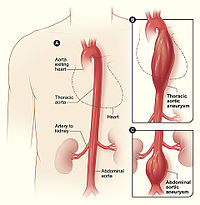
Photo from wikipedia
Objective: To estimate the global and regional prevalence and cases of abdominal aortic aneurysms (AAAs) in 2019 and to evaluate major associated factors. Background: Understanding the global prevalence of AAA… Click to show full abstract
Objective: To estimate the global and regional prevalence and cases of abdominal aortic aneurysms (AAAs) in 2019 and to evaluate major associated factors. Background: Understanding the global prevalence of AAA is essential for optimizing health services and reducing mortality from reputed AAA. Methods: PubMed, MEDLINE, and Embase were searched for articles published until October 11, 2021. Population-based studies that reported AAA prevalence in the general population, defined AAA as an aortic diameter of 30 mm or greater with ultrasonography or computed tomography. A multilevel mixed-effects meta-regression approach was used to establish the relation between age and AAA prevalence for high-demographic sociodemographic index and low-and middle-sociodemographic index countries. Odds ratios of AAA associated factors were pooled using a random-effects method. Results: We retained 54 articles across 19 countries. The global prevalence of AAA among persons aged 30 to 79 years was 0.92% (95% CI, 0.65–1.30), translating to a total of 35.12 million (95% CI, 24.94–49.80) AAA cases in 2019. Smoking, male sex, family history of AAA, advanced age, hypertension, hypercholesterolemia, obesity, cardiovascular disease, cerebrovascular disease, claudication, peripheral artery disease, pulmonary disease, and renal disease were associated with AAA. In 2019, the Western Pacific region had the highest AAA prevalence at 1.31% (95% CI, 0.94–1.85), whereas the African region had the lowest prevalence at 0.33% (95% CI, 0.23–0.48). Conclusions: A substantial proportion of people are affected by AAA. There is a need to optimize epidemiological studies to promptly respond to at-risk and identified cases to improve outcomes.
Journal Title: Annals of Surgery
Year Published: 2022
Link to full text (if available)
Share on Social Media: Sign Up to like & get
recommendations!